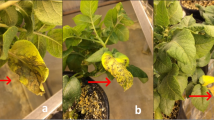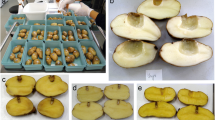Summary
Breeding for resistance to Heterodera rostochiensis was started in Scotland in 1952, using certain clones of Solanum tuberosum subsp. andigena as the source of resistance. Resistance was manifest by the almost complete failure of larvae to mature in the roots of resistant seedlings, particularly those derived from the clone C.P.C.1673.
In 1955 an eelworm population was found which overcame this resistance and was, for this reason, designated as “aggressive”.
Resistance was also overcome in selfed and hybrid seedlings derived from subsp. andigena C.P.C. 1685 and C.P.C.1690. Resistance in Solanum vernei was apparently maintained against the aggressive eelworm population which was studied. This aggressive eelworm population multiplied normally on commercial potato varieties.
In a first survey of Potato Root eelworm infested soils in Britain about 10 per cent of the eelworm populations sampled were found to differentiate little or no resistance in a test plant which was at least simplex for a resistance factor H, derived from C.P.C. 1673.
Samenvatting
Met het kweken op resistentie tegen Heterodera rostochiensis werd in Schotland in 1952 een begin gemaakt. Als bron van resistentie dienden klonen van Solanum tuberosum subsp. andigena. De resistentie uitte zich doordat de larven zich niet ontwikkelen tot geslachtsrijpe dieren in de wortels van resistente zaailingen, in het bijzonder niet in zaailingen, welke afstammen van kloon C.P.C. 1673.
In 1955 werd een populatie van het aardappel-cystenaaltje gevonden, die de resistente planten aantast en om die reden agressief werd genoemd. Resistente zaailingen die door zelfbestuiving of kruising afstammen van andigena C.P.C. 1685 en C.P.C. 1690 bleken eveneens door het agressieve aaltje te worden aangetast. Solanum vernei daarentegen bleek resistent te zijn.
De agressieve populatie vermeerderde zich normaal op de in het verkeer zijnde aardappelrassen.
Uit een eerste overzicht van de met het aardappelcystenaaltje besmette gronden in het Verenigd Koninkrijk blijkt dat een toetsplant, die tenminste simplex is voor het resistentie-gen H (afkomstig van C.P.C. 1673) weinig of geen resistentie toont tegen ongeveer 10% van de verzamelde populaties.
Similar content being viewed by others
References
Anon., Rep. Scot. P1. Breed. Sta., 1956: 5, 16.
Doncaster C. C., A study of host-parasite relationships. The Potato-root eelworm (Heterodera rostochiensis) in Black Nightshade (Solanum nigrum) and Tomato. J. Helminth., 27 (1953): 1–8.
Ellenby C., Resistance to the Potato-Root eelworm, Nature, Lond., 162 (1948): 704.
Ellenby C., Resistance to the Potato Root eelworm, Heterodera rostochiensis Wollenweber. Nature, Lond., 170 (1952): 1016.
Franklin, M. T., The cyst-forming species of Heterodera. Commonwealth Agricultural Bureau, 1951.
Gemmel A. R., The resistance of potato varieties to Heterodera schachtii Schmidt, the potatoroot eelworm. Ann. appl. Biol. 30 (1943): 67–70.
Goodey, T., Laboratory methods for work with plant and soil nematodes. Min. Agric. and Fish. Tech. Bull. No. 2, Lond., 1951.
Grainger, J., Studies on the ecology and control of the Potato Root eelworm, Heterodera rostochiensis. West of Scot. Agr. Coll. Res. Bull. No. 10: 1951.
Jones F. G. W., Observations on the Beet eelworm and other cyst-forming species of Heterodera. Ann. appl. Biol. 37 (1950): 407–440.
Jones F. G. W., First steps in breeding for resistance to potato-root eelworm. Ann. appl. Biol. 41 (1954): 348–353.
O'Brien, D. G. and Prentice, E. G., A nematode disease of potatoes caused by Heterodera schachtii Schmidt. West of Scot. Agr. Coll. Res. Bull. No. 2: 1932.
Toxopeus H. J. and HuijsmanC. A., Genotypical background of resistance to Heterodera rostochiensis in Solanum tuberosum var. andigenum. Nature, Lond., 170 (1952): 1016.
Toxopeus H. J. and HuijsmanC. A., Breeding for resistance to potato root eelworm. I. Preliminary data concerning the inheritance and the nature of resistance. Euphytica, 2 (1953): 180–186.
Toxopeus H. J., Collecting cultivated potatoes in South America for potato breeding. Euphytica 5 (1956): 97–100.
Author information
Authors and Affiliations
Additional information
Hiermede wordt hetzelfde bedoeld als met S. andigenum.
Rights and permissions
About this article
Cite this article
Dunnett, J.M. Variation in pathogenicity of the potato root eelworm (Heterodera rostochiensis woll.,) and its significance in potato breeding. Euphytica 6, 77–89 (1957). https://doi.org/10.1007/BF00179520
Received:
Issue Date:
DOI: https://doi.org/10.1007/BF00179520




